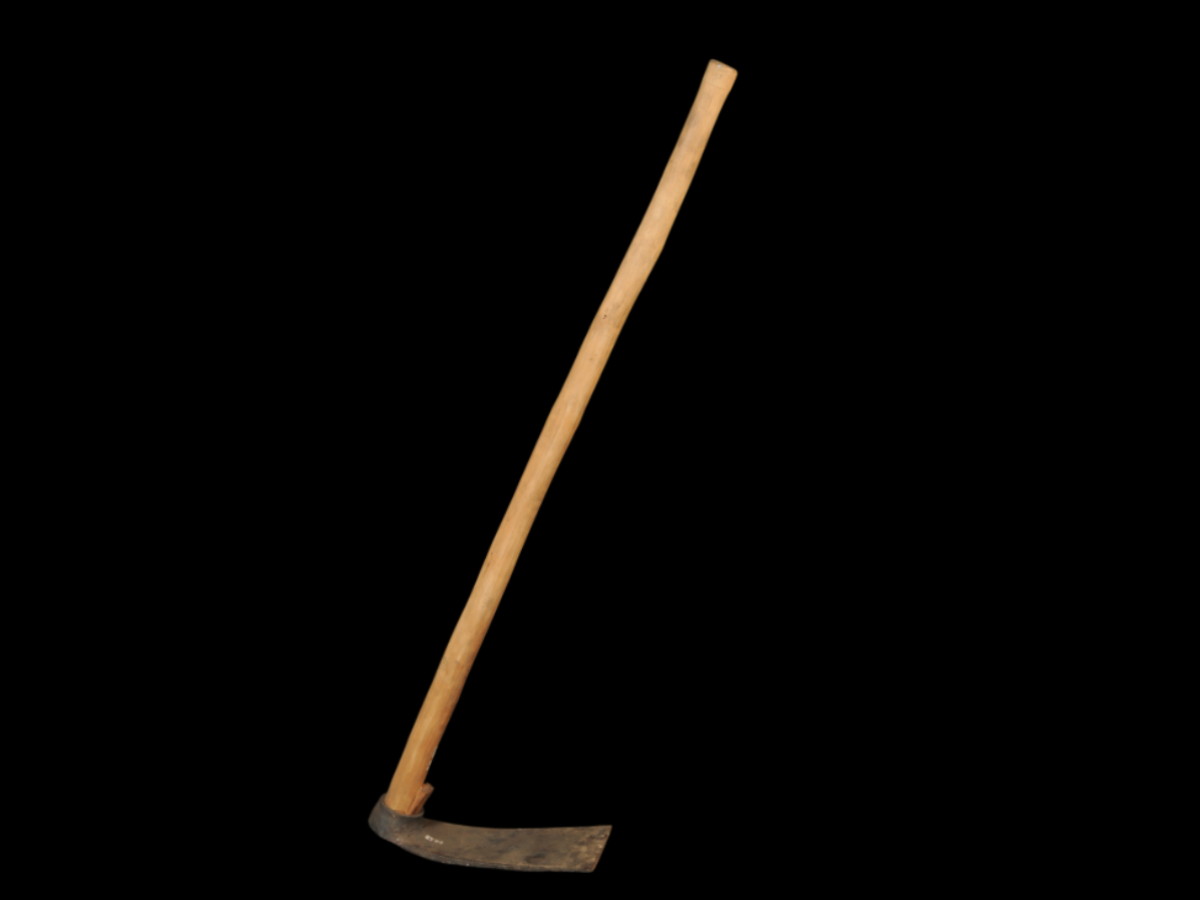State
Tribe Name
Art Type
short description
Known for their extensive culture and traditional crafts, the Rabha tribe is distributed in the Indian states of Assam. A scraper is one of their main tools that is considerably tied into their daily agriculture and woodworking practices.
Rabha scraper consists of two main parts-an iron blade and a wooden handle. A simple wide cutting edge is provided along one of the longer edges for scraping and shaping wood or agricultural produce. On the other side, however, the blade forms an edge that works similarly to a ferrule to attach the handle. A long wooden handle is inserted inside by this ferrule for better grip and to reinforce it; four small wooden wedges are carefully fitted inside the ferrule and holding the blade in place completely. The base of the handle is flat and circular to ensure steadiness while using.
The scraper finds great use in the wood carving and in the processing of bamboo among other agricultural works, becoming one of the most priceless tools in daily life of the Rabha people. Crafting and using such tools underlines indigenous knowledge, self-reliance, and reconciling with nature and such tools being handed down from ancestors to generations is a heritage of expertise in metalwork and woodwork of the community.
Using and maintaining tools like the Rabha scraper will in all likelihood keep traditional techniques of craft and tradition alive while encompassing all the wisdom embedded in indigenous practices. Traditional tools and craftsmanship of the Rabha tribe.
Rabha scraper consists of two main parts-an iron blade and a wooden handle. A simple wide cutting edge is provided along one of the longer edges for scraping and shaping wood or agricultural produce. On the other side, however, the blade forms an edge that works similarly to a ferrule to attach the handle. A long wooden handle is inserted inside by this ferrule for better grip and to reinforce it; four small wooden wedges are carefully fitted inside the ferrule and holding the blade in place completely. The base of the handle is flat and circular to ensure steadiness while using.
The scraper finds great use in the wood carving and in the processing of bamboo among other agricultural works, becoming one of the most priceless tools in daily life of the Rabha people. Crafting and using such tools underlines indigenous knowledge, self-reliance, and reconciling with nature and such tools being handed down from ancestors to generations is a heritage of expertise in metalwork and woodwork of the community.
Using and maintaining tools like the Rabha scraper will in all likelihood keep traditional techniques of craft and tradition alive while encompassing all the wisdom embedded in indigenous practices. Traditional tools and craftsmanship of the Rabha tribe.
Thumbnail

Filter Postion
Right
Filter Background
Off
Theme
Filter Header Image

content
Image

description
Known for their extensive culture and traditional crafts, the Rabha tribe is distributed in the Indian states of Assam. A scraper is one of their main tools that is considerably tied into their daily agriculture and woodworking practices.
Rabha scraper consists of two main parts-an iron blade and a wooden handle. A simple wide cutting edge is provided along one of the longer edges for scraping and shaping wood or agricultural produce. On the other side, however, the blade forms an edge that works similarly to a ferrule to attach the handle. A long wooden handle is inserted inside by this ferrule for better grip and to reinforce it; four small wooden wedges are carefully fitted inside the ferrule and holding the blade in place completely. The base of the handle is flat and circular to ensure steadiness while using.
The scraper finds great use in the wood carving and in the processing of bamboo among other agricultural works, becoming one of the most priceless tools in daily life of the Rabha people. Crafting and using such tools underlines indigenous knowledge, self-reliance, and reconciling with nature and such tools being handed down from ancestors to generations is a heritage of expertise in metalwork and woodwork of the community.
Using and maintaining tools like the Rabha scraper will in all likelihood keep traditional techniques of craft and tradition alive while encompassing all the wisdom embedded in indigenous practices. Traditional tools and craftsmanship of the Rabha tribe.
Rabha scraper consists of two main parts-an iron blade and a wooden handle. A simple wide cutting edge is provided along one of the longer edges for scraping and shaping wood or agricultural produce. On the other side, however, the blade forms an edge that works similarly to a ferrule to attach the handle. A long wooden handle is inserted inside by this ferrule for better grip and to reinforce it; four small wooden wedges are carefully fitted inside the ferrule and holding the blade in place completely. The base of the handle is flat and circular to ensure steadiness while using.
The scraper finds great use in the wood carving and in the processing of bamboo among other agricultural works, becoming one of the most priceless tools in daily life of the Rabha people. Crafting and using such tools underlines indigenous knowledge, self-reliance, and reconciling with nature and such tools being handed down from ancestors to generations is a heritage of expertise in metalwork and woodwork of the community.
Using and maintaining tools like the Rabha scraper will in all likelihood keep traditional techniques of craft and tradition alive while encompassing all the wisdom embedded in indigenous practices. Traditional tools and craftsmanship of the Rabha tribe.
Image Mode
portrait
promoted
Off
Verified
Off
